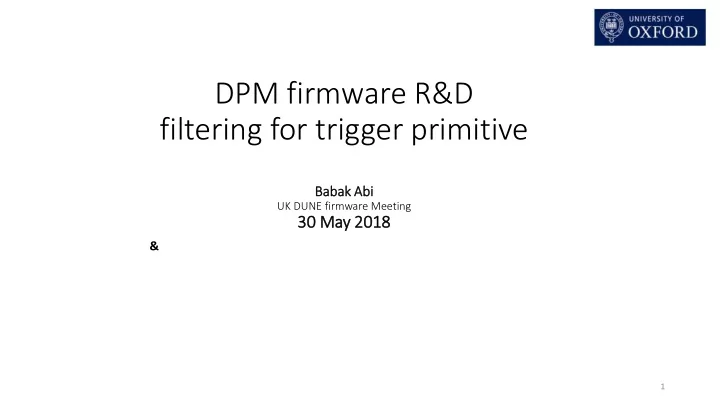

DPM firmware R&D filtering for trigger primitive Ba Babak Abi UK DUNE firmware Meeting 30 30 May 20 2018 18 & 1
DPM Fir irmware R&D • Three main aims : I. DUNE’s new DPM initial tests. (Oct 2018) • RAM & SSD checking, High speed lines (10Gbps). This firmware would be used also in production/commissioning • Hardware platform; New COB !, Jig Board? II. Estimating the FPGA resource needed v.s. various TPC performance level (high to low noise). • Full or partial implementation of blocks of next slide • Some data process and functions are not shown and the buffer block has several sub-blocks III. ProtoDUNE data, real performance check for trigger primitives. • Need to changed to WIB interface , some firmware exist, reuse them? • Some blocks like timing and trigger candidate can be emulated, some like SSD buffer can be removed. • Using SLAC’s FPGA Build Systems & Libraries, RCE Core Firmware. • Centralized build and code with lots of libs • Still there are blocks and places need effort • The Trigger primitives related blocks need more realistic detector simulation 2
DPM Fir irmware R&D Sub Projects How much Where exist already 1-CORE PS/PL Ryan/Larry 2-Compression PL J.J. 3-TPC Interface PL ? 4-Data Splitter PL ? 5-Filter PL Roy, Babak, Peter 6-Hit Finder PL J.J. 7-10GE(TCP) In core PL/PS ? 8- Buffer controller - PL/PS ? DDR4 9- Buffer controller - PS Roy, Babak, Peter SSD 10-GE(serial FELIX) PL ? 11- PS C++ PS ? 12-Time/Trigger Block PL Bristol + ? 3
Fil iltering scheme <-> Noise • For R&D and study filter TPG performance we had suggested a data challenge approach ( talks on https://indico.fnal.gov/event/15347/contribution/6 and https://indico.fnal.gov/event/15612/contribution/2 ): 1) Start with a MC with all physics signal (SN, …) and physics background (radiological,..) and a minimum white noise. 2) Create the python/C++ script with parametrised realistic (as much we understand TPC performance) noise + signal distortion models. 3) Add the noise to extracted raw signal from MC and Run your TPG (hit finder+filter +…) algorithm and extract the performance, efficiency, fake rate, TPG data rate,… 4) Change the parameter or model and study performance and estimate Max/Min resource you need for your TPG based on noise level and model. 1. Current noise implementation: 1)LV regulator FEM level dependency 2)HV plate 3) Pedestal drift 4)non-steady Noise amplitude (Miquel will show in the talk soon) 2. Filter specifications: • How many taps, Classification, X-Pass filter. • Different Filter per channels? Configurable filter? 3. Filter implementation; either VHDL or HLS and Pipelining optimization 4
Back up slides 5
Noise and sig ignal dis istortion: sources • Noise sources, Model, Characteristics; three types of noise in TPC: 1. Fundamental noise (white/pink noise,…) • Comes from analog readout, proportional to the total capacitive load on the input channel(wire length,..) and channel independent • Simulated already in a basic level in MC 2. Parasitic and EMI (pickup noise, HV/LV PSs ….) • Location (channels& ) dependency • Coherent noise spectrum characteristics is steady through time! Might need to be monitored daily bases (done offline ) • Not simulated in MC 3. Detector noise (Microphonic, ..) • characteristics is not steady!? • Signal distortion 1. Pedestal drift, variable Noise ,broken channels 6
• Trigger primitive generation only on Collection? • Induction plane are better even after filtering because they are bipolar • Should we use all channels ? Induction Plane Collection Plane 7
• Noise has been added DATA with Higher Noise
Recommend
More recommend